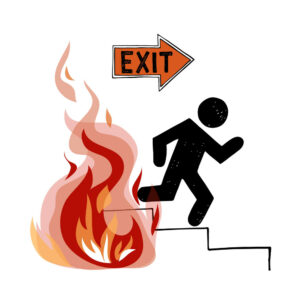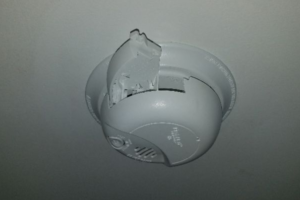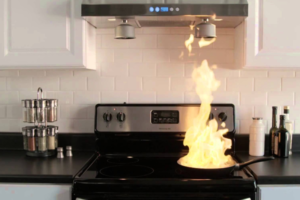Every year the National Fire Protection Association (NFPA) designates a fire prevention week, and today is the day! This week marks 100 years of NFPA’s annual fire prevention week, and the theme this year is Fire Won’t Wait, Plan Your Escape.
Fire Escape Plan

When is the last time you’ve participated in a fire drill?
As children we practice fire drills frequently in school, but have you ever done this with your personal home? Today’s homes burn faster than ever, leaving you with only minutes to escape after the alarms sound. Having a fire escape plan is crucial to make sure you and your family can escape quickly and safely.
Below are some safety tips to keep in mind when planning your fire escape (and plan):
- Draw a map of your home with all points of exit (including both doors and windows)
- Make sure all doors and windows leading outside open easily, and know at least two ways out of every room
- Establish an outside meeting point at a safe distance away from the home where everyone should meet after an evacuation
- Practice your home fire drill both during the day and at night, at least twice a year
- Have a back-up plan. Practice your drill using alternative ways out (during a real fire, one exit may be blocked)
- Teach children how to escape on their own
- Always close doors behind you (a closed door may slow the spread of fire, smoke, and heat)
Fire escape grids are also available at NFPA.org.
Sound the Alarms – Fire is Fast

Our inspectors report inoperable smoke alarms in dozens of homes every day, even though working smoke alarms reduce the risk of dying in home fires by half. Regrettably, almost 60% of reported home fire deaths result from fires in homes with no smoke alarms or no working smoke alarms.
Even with working smoke alarms, fires can happen. Once the alarm sounds, it only takes minutes for thick black smoke to fill your home. Get low and get out ASAP. Unfortunately, only 1/3 of households have developed and practiced a home fire escape plan, according to the NFPA. Develop and practice an escape plan using the tips above!
What’s That Sound?
It’s so important to have smoke and carbon monoxide (CO) alarms in working order, but do you know what their sounds mean?
Smoke Alarms – A continued sound of 3 beeps means smoke or fire is present. Get out of the home immediately and call 911. If you hear a chirp every 30-60 seconds, the battery is low and must be replaced/charged. If chirping continues after the battery has been replaced, the alarm is near the end of its life and needs to be replaced.
Carbon monoxide Alarms – Similar to smoke alarms, if you hear 4 continuous beeps that means carbon monoxide is present in your home. Get out immediately and call 911. A single chirp also means the battery is low and needs to be replaced, and if it continues after the battery has been replaced the unit itself near the end of its life and need to be replaced overall.
The Ever-Present Threat of Burning Flames
According to the National Fire Protection Association (NFPA), fire departments responded to 353,100 home fires which caused 11,030 injuries, 2,620 deaths and $7.2 billion in property damage per year on average between 2014-2018.
The top causes of home fires? Cooking accidents, faulty heating equipment, electrical distribution, and cigarette smoking.
Cooking is Fun – Except When It Starts a Fire
Two of every five home fires start in the kitchen. The sad fact is that most kitchen fires are avoidable. About 1/3 of home cooking fires are caused by inattentive cooks or unattended cook-tops or ovens. The other 2/3 of fires are started because of ignition of food (yes, food catches on fire) or other cooking materials (oils and fats).
Here’s our short list for preventing cooking fires:
- Stay put while cooking – Keep a close eye on the stove when cooking and do not leave unattended
- Clear the cook-top – Keep your stove-top and oven clear of storage

It can happen in the blink of an eye. - Beware little people – Children under five face a higher risk of burns associated with hot food and drinks than being burned in a cooking fire
- Monitor the microwave – Microwaves are one of the leading appliances which cause scald burn injuries
Heating Equipment – Maintain for No Pain
The leading factor contributing to heating equipment fires also is avoidable – failure to clean creosote and other build-up from solid fuel heating equipment (chimneys). Another major factor in house fires is combustibles which ignite because they’re too close to the heater; 1/2 of home heating fire deaths resulted from fires caused by heating equipment too close to things that can burn.
Here’s our short list for preventing heating equipment fires:
- Chim, chimney, cheree – Hire a chimney sweep to clean your chimney
- Distance combustibles – Keep combustibles (upholstered furniture, clothing, mattresses, bedding) away from heat sources
- Avoid space heaters – Fixed or portable space heaters are involved in about 4 out of 5 heating fire deaths

Curtains too close to the baseboard heater. - Cord review – Check all cords for frays or cracks, which can spark and cause fires
- Service the electrics – All electrical components in your home should be serviced and monitored; about half of home electrical fires involved electrical distribution or lighting equipment
- Service the appliances – Other suspects for starting fires include washer, dryer, air conditioning equipment, water heater and range; get an annual service contract to have the equipment checked by a professional.
Bed is for Sleeping, Not Smoking
Most fires caused by cigarettes are related to a person falling asleep while smoking. Sleep-related smoking fires are a factor in almost 1/3 of home smoking material fire deaths. Don’t smoke in bed.
Safety First
There are many areas regarding fire safety that require vigilance, including home inspection issues which we report consistently. The good news is that proper prevention and consistently applied home safety techniques can significantly reduce the probability of home fires!
